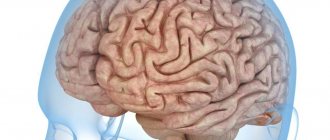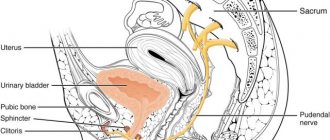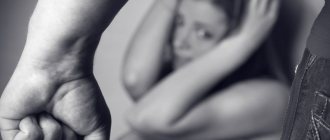Brain topography
Each part of the brain has its own functions. For example, information obtained through vision
is analyzed in the occipital region of the brain.
And the movement
is controlled by a fairly narrow strip of nervous tissue that stretches from the top of the head to the ear, like the earpiece of headphones.
Brain training
Is your memory failing? It’s not surprising, because she suffers without load in the same way as her muscles. Memory development exercises will help you - you can start doing them at any age.
At the same time, vision, hearing, movement, and all tactile sensations are controlled in a mirror way.
So, if a person has a stroke in the left hemisphere, the motor functions of the right side of the body are impaired. Next to the motor area is the area where tactile sensations
.
Therefore, often when the brain is damaged, a person simultaneously loses both the ability to move and the ability to feel. The perception of auditory information
occurs in the temporal region of the brain.
In right-handed people, the left temporal lobe is responsible for understanding words and expressing one's own thoughts. Right temporal lobe – helps to hear music and identify various noises. The area of the brain where the visual and auditory areas meet is responsible for the function of reading
- converting visual images into sounds.
How is a woman's brain different from a man's?
There are many different fantasies and myths on this topic. Very often, women are attributed to frivolity, irresponsibility and emotionality, although in fact research shows that women cope well with difficult and serious problems - even leading combat squadrons, and men are no less emotional, they are just taught to express only certain emotions, and the rest - somatize. Men are credited with being responsible, rational, and focused, when in fact men, for example, are much more likely to miss project deadlines, generally absent themselves more and quit more often, make logical errors with the same frequency, and are quite often absent-minded - more often distracted than women.
However, modern studies of MRI images are revealing true structural differences. We'll talk about them today. So, scientists identify the following types in the differences between the male and female brains: the ratio of white and gray matter, physiology, blood supply and innervation.
From a scientific point of view
The ratio of white and gray matter is different in men and women: men have slightly more gray matter, and women have slightly more white matter. Gray matter is localized, grouped and responsible for analysis, it is a kind of processor. White matter is the connection, it is responsible for the communication of neurons with each other. Men have more processing areas, women have more connecting areas.
Too many different tasks for women also leads to burnout and procrastination, just like for men, and many men are unable to concentrate on one thing for a long time and need breaks.
That is, this relationship is from the category of “rather” and “to some extent”, and not “women are designed for a large number of tasks, and men have perfect focus.”
Physiology
The bodies of men and women contain the same substances, but in different quantities - primarily we are talking about serotonin, testosterone, oxytocin and estrogen.
Women have more serotonin, oxytocin and estrogen - it is due to this that they have greater perseverance, sensitivity, emotional competence and the ability to create stronger human relationships. Female friendship is in vain ridiculed: statistically, it is women who have the longest, most trusting and warm contacts with women - in contrast to intergender contacts or “strong male friendships.”
Testosterone and lower levels of other hormones are associated with less perseverance and more aggressiveness in men, as well as decreased empathy when absorbed in tasks. This leads to men having a harder time coping with stress, being more likely to suffer from depression and being more likely to commit suicide. Paradoxically, this also means that men are encouraged to cry more to reduce the level of cortisol in the blood, a stress hormone that, when accumulated in the body, weakens the immune system, breaks down muscles and causes depression.
Structural differences
Women have a larger hippocampus, as well as more areas responsible for language; in men they tend to be mainly concentrated in one hemisphere, and in women - in both. Due to this, women have better access to information received from different senses, can more easily describe their experiences and emotions, and also remember more sounds, smells, sensations and visual details.
Blood supply and innervation
With a more efficient blood supply, women's brains tend to be less drained and better able to process memories, experiences, and emotions. Men get tired of this process faster and prefer to move on to active actions. This is why their actions tend to be less thoughtful, especially in areas related to relationships with other people: men are less able to predict the impact of their words and actions and the consequences in the form of changes in other people's attitudes. Women have higher social competence.
To summarize: women cope better with stress, make more informed decisions regarding other people, switch from task to task more easily, analyze and use past experiences better, and build relationships with other people better.
Men are more impulsive, less able to handle stress, less empathetic, and less understanding of other people's actions. At the same time, they focus better and move to action faster.
In general, according to research by Gregory Janz, men and women have more than 100 differences in the brain (do not forget about individual differences within the sexes). As a rule, the consequences of these differences lie not in the area of “smarter - dumber”, but in the area of “rather more inclined” and “rather less inclined”. Despite the average indicators, in life there are sensitive, reasonable men and indifferent, impetuous women.
Gregory Jantz believes that because of these differences in the nervous system, it is important to teach men stress management, perseverance, and greater emotional competence, while helping women gain more confidence to better use their brain strengths.
Frontal lobes – “management company”
The largest part of the brain is the frontal lobe. One of the main functions of this part of the brain is planning
- the ability to perform actions that require several different actions.
In order for the sequence of actions to be correct, the frontal lobes perform another function - organizational
.
Additionally, the frontal lobes play an important role in the control of emotions
.
In the deep parts of the brain there are areas responsible for primitive emotions: hunger, aggression and sexual desire. These structures send messages to the parts of the brain responsible for action. The frontal lobes control this process through the so-called stop function
. So, for example, if emotions dictate to hit the boss, the frontal lobes signal: “Stop, or you will lose your job.” This function is for notification purposes only. The frontal lobes, of course, cannot turn off emotions and stop actions.
Why and when do you need to develop a child’s brain?
It is important for parents to learn how to properly develop the child’s mental abilities in order to correctly and timely stimulate the child’s cognitive interest and begin the process of learning various skills. For the development of a child's brain, exercise is necessary, without which synapses - neural nodes - will not form. If you do not repeat a memorized poem from time to time, it may be forgotten over time. The same thing happens with synapses, which, if left idle, weaken, and, in the end, can completely collapse if exercises for brain development are not used. Until the age of 10, the work of a child’s brain absorbs a huge amount of energy - much more than what the adult brain requires. Given this activity, children need to do brain exercises as often as possible. Ordinary life situations are best suited for this. The introduction of educational moments into games is all the more important, since it is known that a child will never perceive information conveyed in the usual way as deeply as that which came to him in the context of experienced emotions.
Soldiers of the invisible front
At the back of the brain is the cerebellum
.
Its volume is approximately one-eighth the size of the cerebral hemispheres. Despite its small size, this part of the brain controls coordination of movements
(the joint work of all muscles) and
the sense of balance
.
Thanks to the work of the cerebellum, a person can stand on his feet, maintain balance and move around. The brain stem
is located under the cerebral hemispheres and behind the cerebellum.
It connects the spinal cord and brain and controls all the functions that are necessary to maintain life in the body. The trunk is responsible for the involuntary work of muscles during breathing, heartbeat, food digestion and blood circulation. It works automatically and without interruption
.
How to prolong youth?
One of the mechanisms leading to aging is the death of nerve cells. The less a person strains his brain, the larger this process becomes. Find out how to stop this process and delay old age.
The brain stem is also responsible for sorting and distributing messages that the brain receives from the rest of the body.
Another notable area of the brain is the hippocampus
.
This paired formation, located in the temporal lobes of the hemispheres, controls memory
.
More precisely, by transferring information from short-term memory storage to long-term memory. The pituitary gland
is located on the lower surface of the brain - in a special bony cavity called the sella turcica.
The size of the pituitary gland is very small - no more than a pea. Its task is to control the production and release of all hormones
in the body.
Produces the pituitary gland and its own hormones - for example, growth hormone. The hypothalamus
is located practically in the geometric center of the brain.
It synchronizes the work of the nervous and endocrine systems of the body, working closely with the pituitary gland. For example, it is responsible for a kind of internal thermometer that maintains the temperature of the entire body
. If it increases, the hypothalamus sends a complex neurohormonal message that stimulates sweating. If it decreases, it gives a command for muscle tremors.
Checking the hemispheres: which is more developed?
It is not at all difficult to check which type of thinking predominates in a child - logical or intuitive. There is no need for physical devices here; the body functions themselves will give the answer. Each hemisphere controls a different side of the brain. The side that is dominant will indicate the dominant hemisphere. The child should be asked to do the following:
- put your palms together, interlace your fingers and extend the “lock” forward, paying attention to which thumb is on top;
- applaud by turning your hands horizontally and seeing which palm is on top;
- Cross your arms over your chest and see which one will be on top.
There are many other ways to determine the “side” of thinking. For example, “a spinning girl,” where you need to imagine in which direction she is spinning. Interestingly, her pose allows her to rotate in both directions. If both hemispheres are developed harmoniously, then the choice can fall in both directions. But even if the imagination gives preference to one type of rotation, then there is nothing to worry about. There are many exercises and techniques with which you can comprehensively train your brain.
Exercises to develop both hemispheres of the brain
There are several effective methods that are suitable not only for children, but also for adults. Brain training exercises balance the hemispheres through physical activity of the body and emotions.
"Ear and Nose"
You need to touch the tip of your nose with your left hand, and with your right hand grab your left ear. After clapping your hands, change the position of your hands to the opposite. Many adults are not able to do this exercise at first, which makes children happy.
"Wave"
Rhythmically clench your right hand into a fist, and at the same time depict a wave with your left. Then change movements between hands. How many times will the fist make a wave?
"Pet yourself"
This exercise was previously used in elementary schools during five-minute exercises. You need to tap the top of your head with your right hand, and stroke your stomach with your left. You can make the exercise more difficult by lifting your leg and rotating it, and then quickly change the movements of your arms and leg.
"Cross Movements"
Touch your left heel with your right hand, and then touch your right heel with your left hand. Then change movements - right hand to the right heel, and accordingly the left. Perform the last exercise at least 6 times, then return to cross touches and gradually increase the speed of execution, trying not to lose track
A good exercise for the fingers, training their fine motor skills and the corresponding parts of the cerebral cortex. The thumb should be connected in turn into a ring with the index finger, then with the middle, ring and little fingers. First you need to train one hand, then the other, and then try to work with both hands at once, moving your fingers as quickly as possible.
"Conductor"
To perform it, you need to imagine yourself as an orchestra conductor, turn on familiar music, and raise both hands to shoulder level - one slightly higher than the other. In this position, begin to draw a figure eight in the air: with your right hand from the middle of the figure to the right and up, and with your left to the left and up. Then repeat the movement in reverse order. Sports juggling develops manual dexterity, attentiveness, activates both types of thinking, and trains the intellect. Children develop creatively and become confident in their abilities.
"Mirror Drawing" or "Double Doodles"
During this exercise, both hands (or legs) simultaneously draw mirror figures. With its help, the transition from gross to fine motor skills is facilitated, the skill of following instructions is developed, concentration is trained, and writing, reading, mathematics and spatial perception skills are improved. Draw on an easel or board at the same time with both hands, armed with colored felt-tip pens, like mirrored figures. The hands must make synchronous movements: now one towards the other, now diverging, now up, now down, and curious figures will appear on the board. You can stand behind the child to help him, guiding his hands. Let him learn to make movements from the sternum, the midline of the body. You need to give commands out loud: “up”, “to the side”, “down”, “towards the center”, so that he draws circles, squares, triangles and other shapes with both hands at the same time. Then he must continue this activity on his own after he learns to easily draw “mirror figures.” Having started drawing on a large board, the child should then try to repeat it on a small piece of paper. You can draw with anything - markers, pencils, paints, chalk.
Sense organs
It is believed that a woman is more sensitive, but not emotional. She has a very well developed ear, which is why gentle words, timbre of voice, music, etc. are important to her. Her tactile sensitivity is more developed: a woman’s skin contains 10 times more receptors sensitive to touch than a man’s. In addition, oxytocin and prolactin (attachment and affection hormones) increase her need for touch and affection. The perception of smell in women is pronounced and increases 100 times during the menstrual cycle. Her vomeronasal organ (Vomero Nazal Organ) is truly a sixth sense that allows you to distinguish pheromones that express different kinds of emotions: sexual desire, fear, anger, sadness. Maybe this is called intuition?
As for vision, in men it is more developed and more eroticized: hence their interest and excitement caused by clothes, makeup, jewelry, nudity, and pornographic magazines. However, women have better developed visual memory (for faces, the order of objects, the shape of objects, etc.).
Literature
- Aron Claude La Sexualit 2 (Pheromones et desir). Paris: Odoile Jacob. 2000, p. 206.
- Badinter elisabethxy, de l'identite masculine. Paris: Odile Jacob. 1992, p. 315.
- Braconnier Alain Le sexe des emotions. Paris: Odile Jacob. 1996, p. 210.
- Crepault Claude La sexoanalyse. Paris: Payot 1997.
- Cyrulnik Boris Les nourritures affectives. Paris: Odile Jacob. 1993, p. 244.
- Durden-Smith & DESIMONE (83) Sex and the Brain. USA. P. 270.
- Ginger S. et al. La Gestalt, une therapy du contact. Paris: Hommes et Groupes. 6th ed. 2000, p. 535 Chapitres 12 et 13, 1987, p. 297 to 324 & 332 to 346.
- Ginger Serge La Gestalt, l'art du contact. Bruxelles: Guide de poche Marabout. 5th ed. 2001, p. 288 chap. 6 et 7 (p. 93 to 132), 1995.
- Gray John Men are from Mars, Women are from Venus. Haroer Collins (USA), 1998.
- Janov Arthur The Biology of Love. New York: Prometheus Books. 2000, p. 380.
- Kimura Doreen Sex and Cognition. MIT Press. 2000, p. 230.
- Krause-Girth Cornelia The position of Women in Psychotherapy (lecture in Frankfurt & Paris), 2001.
- Le Vay Simon The Sexual Brain. Cambridge (Mass.): MIT Press 1993, p. 230.
- Marge S. Et Vigier B. Developpement et differenciation sexuelle de l'appareil genital, in La reproduction chez les mammiferes et l'homme. Paris: Ellipses, 2001.
- Pease Allan & Barbara Why Men Don't Listen and Women Can't Read Maps. Orion. 2001, p. 430.
- Plomin R. et al. Behavioral Genetics. Freeman & Company, New York. 1997.
- Vincent JD Biologie des Passions. Paris: Odile Jacob. 1986, p. 352.
- Willer Ellen Les hommes, les femmes, etc. Bruxelles: Marabout. 2001, p. 190.
Exercises to train the left hemisphere
The more “mathematical” left hemisphere deals with calculations and analysis. The best types of exercise for him are studying the exact sciences, including solving mathematical problems. The greater the number of tasks and the more complex they are, the more developed the left hemisphere becomes. This includes solving crossword puzzles, puzzles, and sudoku. In these classes, analytical thinking, located on the left side, works, which is why she trains more. If parents know how to develop both hemispheres of the child's brain, then they can make the learning process fun, which will help the child improve more effectively. By doing simple brain development exercises, the whole family can have an interesting and fun time. Later, it will not be difficult to notice how much more balanced, attentive, happy and healthy the child has become - and isn’t this a success?
Nature and cultivation
Today, experts in the field of neurology and genetics believe that our personality is determined and determined one-third by heredity, one-third by intrauterine life. Personality is determined one third by acquired knowledge, which is influenced by the cultural environment, level of education, upbringing, random circumstances or psychotherapy.
During the first weeks after fertilization, the embryo is female (Durdeen-Smith & Desimone, 1983; Badintez, 1992; Magre & All, 2001), and masculinization is a slow and difficult transformation. Thus, a girl is not a boy who has lost his penis (Freud's hypothesis), but a boy is a girl who has won (acquired) a penis. The so-called desire or need for a penis in psychoanalysis is a hypothesis that has never been tested. Among transsexuals, you can find 5 times more men who want to become a woman than women who want to become a man. During wars, twice as many male homosexuals are born, probably because mothers experienced stress that disrupted hormonal balance (Durdeen-Smith & Desimone, 1983; Le Vay, 1993).
These two parts—hereditary and congenital—seem to be important. According to various studies, if one of the identical twins is homosexual, then the second will also be homosexual in 50-65% of cases; in cases of fraternal twins in 25-30% of cases, which is 5 times more than in the general population. In most cases, homosexuality can be predicted as early as 1–2 years of age (Le Vay, 1993).
In a more general approach, interpersonal correlation is due to:
- heredity (50% between identical twins);
- hormonal saturation during fetal development (25% between fraternal twins);
- upbringing (10% between brothers and sisters);
- lack of correlation between strangers.
The influence of heredity, intrauterine life, and knowledge acquired throughout life, according to scientists at the University of Minnesota, affects mental activity, music perception, athletic achievements, and even optimism to varying degrees.










